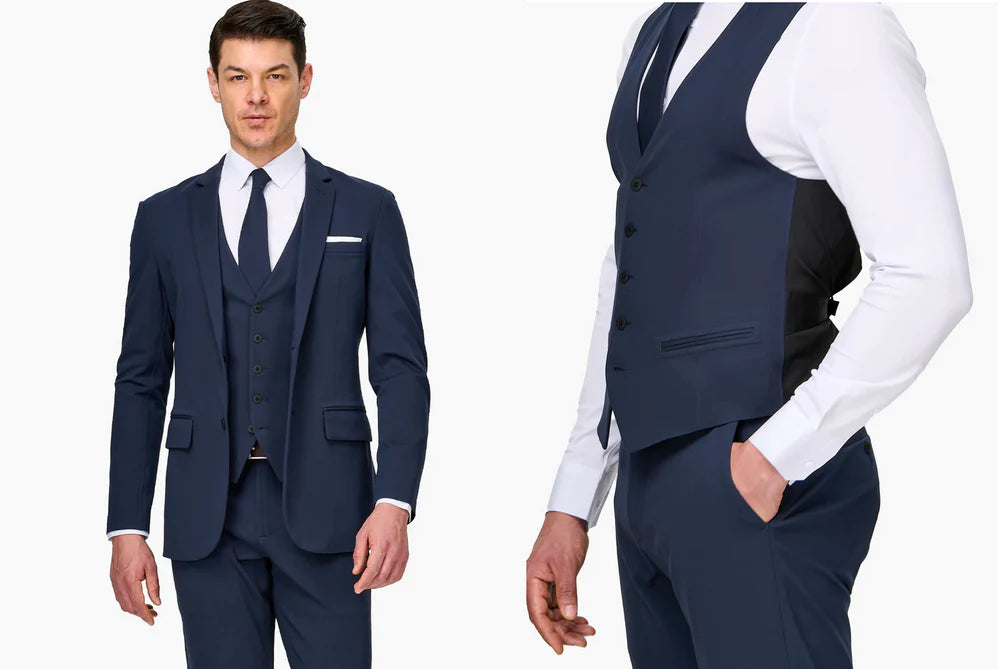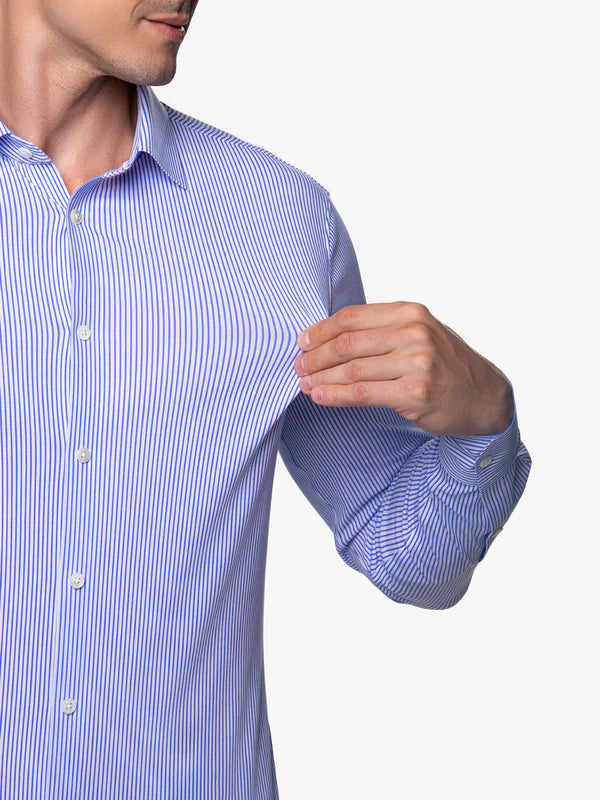When it comes to dressing sharply, nothing beats the timeless elegance of a well-fitted suit. Whether you're attending a formal event, a crucial business meeting, or simply wish to make an impression, the right men's suit can speak volumes about your style and personality. But with a plethora of choices available, how do you select the perfect ensemble?
Our comprehensive suit buying guide will help you become an expert in no time. Soon, you will be able to buy the best suit jackets, dress pants, sports coats, and any other men’s dress suit item you’ve been trying to find.
1. Understanding Suit Basics: Suit Types
Diving into the world of dress suits might initially seem daunting, but breaking it down to basics can simplify the process. The construction and style of the suit are foundational aspects that determine its overall look and feel. The primary types of suits are single-breasted or double-breasted:
- Single-breasted Suits: This is the most common and versatile type of suit, ideal for almost any occasion, be it a business meeting or a casual event. Single-breasted suits come with a single row of buttons (typically two or three) with a narrow overlap of fabric. The design creates a sleek silhouette, making it suitable for most body types and exuding a modern appeal.
- Double-breasted Suits: More formal and a tad more intricate in design, double-breasted suits boast a broader overlap with two parallel rows of buttons. The design naturally offers a sense of width, making it particularly flattering for taller individuals. It's a classic choice that has made a significant comeback in recent fashion cycles, echoing vintage charm with a contemporary twist.
While selecting between single and double-breasted suit jackets, always consider the occasion and your body type. But remember, confidence in wearing your choice is the key to truly pulling it off.
2. Fabrics Matter: Choose Wisely
A suit's fabric doesn't just influence its appearance but also comfort, durability, and how it drapes on your body. Here’s a deeper dive into popular suit materials:
- Wool: Wool reigns supreme among suit fabrics. It's naturally resilient, wrinkle-resistant, and has a refined appearance. Within wool, there are various types like merino, cashmere, and tweed, each offering a distinct texture and weight.
- Linen: Perfect for warmer climates, linen is breathable and lightweight. It lends a casual, laid-back vibe but tends to wrinkle easily, which can be a concern for some.
- Cotton: A mid-range option between wool and linen, cotton is breathable and comfortable. While it's less formal than wool, it's an excellent option for semi-formal and casual settings.
- Synthetic: Synthetic materials, including polyester, are often blended with natural fibers to enhance certain properties like wrinkle resistance. However, pure synthetic suits might lack the breathability and luxurious feel of natural fabrics.
- xSuit's Innovative Blend: The game-changer in the realm of suit fabrics is xSuit's innovative blend of 60% viscose, 31% polyamide, and 9% elastane. Viscose, derived from natural cellulose, offers silk-like aesthetics and breathability. Polyamide enhances durability and resilience, while elastane provides flexibility, ensuring the suit hugs your body just right. This unique combination ensures that xSuit doesn't just offer another suit; it delivers an innovative experience - marrying comfort and style in every thread.
When choosing a suit fabric, consider the climate, occasion, and your comfort. While traditional fabrics have their merits, innovative blends, like that of xSuit, bring forth the best of both worlds, allowing modern men to embrace tradition with the benefits of contemporary technology.

3. The Right Fit is Paramount
The allure of a suit is as much in its fit as in its fabric. Even the most exquisite and expensive suit can falter if it doesn't sit on your frame correctly. As styles and trends evolve, the definition of a 'perfect suit fit' may shift, but certain universal principles remain unchanged. Here's a deeper dive into ensuring your suit fits like a glove:
- Shoulders: This is the most crucial part. The suit's shoulder should align perfectly with your own. If the seam juts out or droops down, it's a clear sign that the fit is off. The shoulder pads (if any) should not create an angular appearance; instead, they should feel natural.
- Chest & Torso: When buttoned up, the suit should feel snug but not tight. You should be able to easily slip a hand between your chest and the suit jacket. The jacket should contour to the shape of your torso without feeling restrictive or creating an 'X' shape due to pulling.
- Length: A classic suit jacket should cover the length of your bottom. However, contemporary styles sometimes favor slightly shorter lengths. The sleeves, on the other hand, should end just above the wrists, showing off a bit of your shirt cuff.
- Trousers: High-waisted or regular, the trousers should sit comfortably at your waist. The break (where the trouser ends) should be on top of your dress shoes, resulting in a small crease – a sign of a good fit.
While these guidelines provide a roadmap, personal comfort is paramount. Whether you prefer a slim fit, classic fit, or a more relaxed one, the suit should empower you with confidence and allow for ease of movement.
4. Style Nuances to Consider
Beyond the foundational elements of suits lie subtle details that can dramatically impact the overall aesthetic. These nuances allow you to inject personal style, ensuring your ensemble stands out:
- Lapels: The kind of lapel you opt for can set the tone for your suit. Notched lapels are versatile and standard for business suits. Peaked lapels, with their upward-pointing edges, are a tad more formal and are often seen on double-breasted suits or tuxedos. Shawl lapels, with their continuous curve, are primarily reserved for tuxedos and more formal occasions.
- Vents: These are the slits at the back of your suit jacket. A single vent is more contemporary and is often seen on casual and slim-fit suits. Double vents, on the other hand, are traditional and allow for better movement, making the suit fall more gracefully.
- Pockets: The type and placement of pockets can influence the suit's look. Flap pockets are common and versatile. Jetted pockets, without flaps, present a more streamlined and formal appearance. For a touch of flair, a ticket pocket (smaller pocket above the regular one) can be a stylish addition.
- Buttons: The number and arrangement of buttons can alter a suit's vibe. Two-button single-breasted suits are universally flattering and popular. Three-button versions offer a higher closure, suited for taller individuals. For double-breasted suits, the 6-button arrangement is classic.
- Textures: The texture of your suit can add an additional dimension to its appearance (as well as its utility). Beyond the color and cut, a suit's texture can play a pivotal role in its visual appeal. For instance, a smooth worsted wool gives a sleek and polished look, while fabrics like flannel or tweed offer a coarser, more tactile appearance that's rich and multidimensional.
While these style nuances offer guidance, fashion is deeply personal. Use these as starting points and then mold your suit to reflect your individuality, ensuring it resonates with your personality and the statement you wish to make.
5. Color & Pattern Choices: Types of Suit Patterns
The palette and patterns of your suit can greatly influence its vibe and versatility. While some colors and designs are deemed classic and essential, there's room for experimentation and personal expression. Below, we outline the basic types of suit patterns for you to consider:
- Classic Colors: Black suits, navy suits, and gray suits are the holy trinity of suit colors. These shades promise versatility, making them suitable for both day-to-day wear and special occasions. A navy or gray suit can transition effortlessly from a business meeting to a dinner date.
- Venturing Beyond Neutrals: While neutrals are safe and adaptable, don't shy away from exploring other hues. A deep green or rich burgundy can be a refreshing choice for events that don't demand strict formality. Such colors can exude confidence and showcase your individual style.
- Patterns for Personality: If solid colors are too monotonous for your taste, patterns come to the rescue. Pinstripes, though traditional, can offer a refined and elongated appearance. Checks, ranging from subtle windowpanes to bold plaids, can add a touch of flair. Houndstooth or birdseye patterns, while less common, can make a sophisticated statement.
When playing with dress suit patterns, remember to balance them with solid pieces to avoid clashing. For instance, a checked suit pairs best with a solid dress shirt and tie. The key is to let one element of your ensemble take center stage.
Both color and pattern choices should reflect not just current trends but also your personal style and the setting in which you'll wear the suit. Whether you're a staunch traditionalist or someone who loves to push the fashion envelope, there's a spectrum of choices awaiting you. Remember, though, that its usually best to wear matching suit separates — otherwise, we’re entering a whole other world of suit styling.

6. Harnessing Innovation with xSuit
In the realm of fashion, where tradition meets modernity, the genuine magic happens. In the context of men's suits, blending age-old tailoring principles with contemporary innovations can redefine what it means to wear a suit. Enter xSuit — a brand that embodies this philosophy.
xSuit isn’t your typical suit manufacturer. Our commitment to innovation is evident in the unique fabric blend they employ: 60% viscose for a soft, breathable finish, 31% polyamide for enhanced durability, and 9% elastane for that touch of stretch, ensuring a fit that moves with you. This combination provides wearers with a suit that isn’t just about looks but is a testament to functional fashion.
With its unique fabric composition, the xSuit offers unparalleled resilience without compromising on comfort. This means fewer trips to the dry cleaner, resistance to wrinkles, and a suit that stands up to the challenges of daily wear, be it a long day at the office or a night out in the city.
The Art of Buying a Dress Suit For Men
Choosing the right dress suit is more than just a purchase; it's an investment in elegance, confidence, and style. With this guide, you're equipped to make an informed decision, ensuring you step out not just looking good but feeling phenomenal. Remember, a suit doesn't just add to your wardrobe; it adds to your persona. So choose wisely, trust in brands like xSuit that prioritize quality and innovation, and wear your ensemble with pride.


